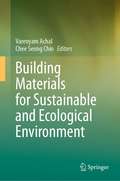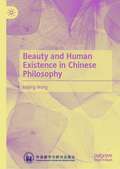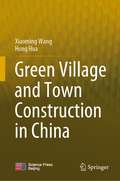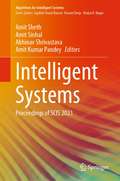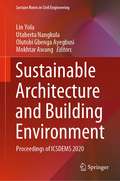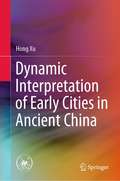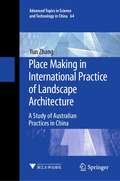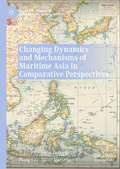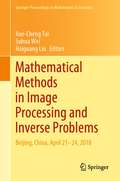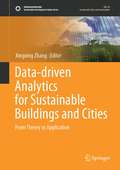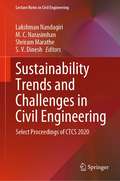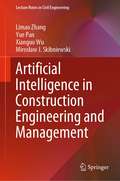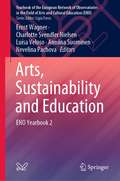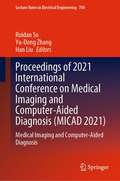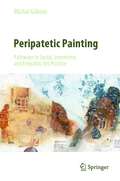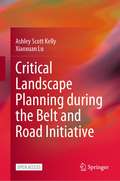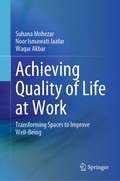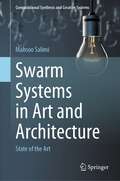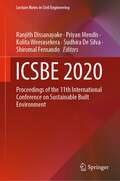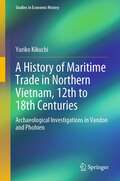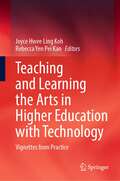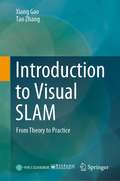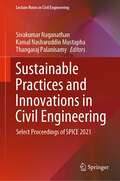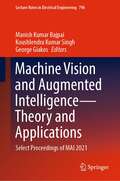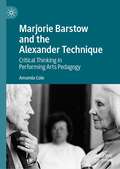- Table View
- List View
Building Materials for Sustainable and Ecological Environment
by Varenyam Achal Chee Seong ChinThis book uses theories, hypotheses, policies, practical insights and case studies to introduce and elucidate green building materials for sustainable construction. Cement is the most widely used building material in construction; however, it is not sustainable, being responsible for 7% of global carbon dioxide emissions and consuming huge quantities of energy. In order to limit the ecological damage, sustainable building materials are needed. Ecosystems are a source of important lessons and models for transitioning the built environment onto a sustainable path that opens options for sustainable building material in construction. The book provides a guide for readers seeking knowledge on sustainable building materials with the potential to lower environmental impact by reducing CO2 emission throughout the building’s lifecycle. The book is motivated by recent rapid advances in sustainable building materials production, including green building materials made of industrial by-products and recycled wastes, earth materials, plant-based materials, microbial-based materials or supplementary cementitious materials, to reduce the environmental impacts of traditional building materials. Discussing the development and applications of various sustainable building materials, including related case studies, and addressing the environmental issue with a holistic and systematic approach that creates an ecology of construction for sustainability in infrastructures, it offers promising solutions to achieve renewable and sustainable building materials for the future.
Beauty and Human Existence in Chinese Philosophy
by Keping WangThis book considers the Chinese conception of beauty from a historical perspective with regard to its significant relation to human personality and human existence. It examines the etymological implications of the pictographic character mei, the totemic symbolism of beauty, the ferocious beauty of the bronzeware. Further on, it proceeds to look into the conceptual progression of beauty in such main schools of thought as Confucianism, Daoism and Chan Buddhism. Then, it goes on to illustrate through art and literature the leading principles of equilibriumharmony, spontaneous naturalness, subtle void and synthetic possibilities. It also offers a discussion of modern change and transcultural creation conducted with particular reference to the theory of the poetic state par excellence (yi jing shuo) and that of art as sedimentation (ji dian shuo).
Green Village and Town Construction in China
by Xiaoming Wang Hong HuaBy means of multidisciplinary research on urban and rural planning, construction engineering, environmental engineering and engineering sociology, this book conducts pioneering research on the construction theory, construction methods, evaluation technology and application of demonstration projects in China’s green villages and towns. The book is divided into three parts and eleven chapters. Part I is about the theory and development of green village and town construction, including the theory and innovation, the evolution and development, the patterns and mechanisms, and the community of green village and town construction. Part II is about the planning and construction methods of green villages and towns, including the plan compilation, the environmental infrastructure construction, and the construction and renovation of green buildings in villages and towns. Part III is about the evaluation of the planning and construction of green villages and towns, including the evaluation of plans, the evaluation of environmental infrastructure construction, the evaluation of green building construction, and the comprehensive evaluation of the planning and construction of green villages and towns. Today, 564 million farmers live in 28,500 towns and 2.452 million villages in China. In 2018 alone, 820 million m2 of new houses were built in rural areas. This proves that China’s green village and town construction has great significance and can provide enlightenment to developing countries and even to the world. The book describes new theories, new perspectives and new methods of green village and town sustainable construction in China for overseas experts and readers.
Intelligent Systems: Proceedings of SCIS 2021 (Algorithms for Intelligent Systems)
by Amit Sheth Amit Sinhal Abhinav Shrivastava Amit Kumar PandeyThis book contains the latest computational intelligence methodologies and applications. This book is a collection of selected papers presented at International Conference on Sustainable Computing and Intelligent Systems (SCIS 2021), held in Jaipur, India, during February 5–6, 2021. It includes novel and innovative work from experts, practitioners, scientists, and decision-makers from academia and industry. It covers selected papers in the area of artificial intelligence and intelligent systems, intelligent business systems, machine intelligence, computer vision, Web intelligence, big data analytics, swarm intelligence, and related topics.
Sustainable Architecture and Building Environment: Proceedings of ICSDEMS 2020 (Lecture Notes in Civil Engineering #161)
by Lin Yola Utaberta Nangkula Olutobi Gbenga Ayegbusi Mokhtar AwangThis book presents articles from the International Conference on Sustainable Design, Engineering, Management, and Sciences (ICSDEMS 2020), held in Bali, Indonesia. It highlights recent advances in civil engineering and sustainability, bringing together researchers and professionals to address the latest, most relevant issues in these areas.
Dynamic Interpretation of Early Cities in Ancient China
by Hong XuThis book offers an archaeological study on China’s ancient capitals. Using abundant illustrations of ancient capital sites, it verifies the archaeological discoveries with documentary records. The author introduces the dynamical interpretation of each ancient capital to the interpretation of the entire development history of China's ancient capitals. The book points out that for most of the almost 2000 years from the earliest Erlitou (二里头)to the Ye city (邺城), there was an era where ancient capitals didn’t have outer enclosures due to factors such as the strong national power, the military and diplomatic advantage, the complexity of the residents, and the natural conditions. Thus an era of “the huge ancient capitals without guards” lasting for over 1000 years formed. The concept that “China’s ancient capitals don’t have outer enclosures” presented in the book questions the traditional view that “every settlement has walled enclosures”. Combining science with theory, it offers researchers of history a clear understanding of the development process of China’s ancient capitals.
Place Making in International Practice of Landscape Architecture: A Study of Australian Practices in China (Advanced Topics in Science and Technology in China #64)
by Yun ZhangThis book explores international practice in landscape architecture, focusing on the provision of services from Australia to China during China’s contemporary urbanization and Australian landscape architects’ approaches to place. Landscape architectural practice requires planners and designers to have a deep understanding of local culture, site characteristics, craftsmanship and even project procedures that are often intangible. How to acquire the above local knowledge has become a major challenge for international teams. Through the survey of the practice of Australian landscape practices in China and the case study of Li Lake planning and design project, this book reveals the process and difficulties of landscape planning and design as a transnational practice, as well as its special value as a way of cross-cultural fertilization. This book is intended for students, practitioners and researchers in the fields of landscape architecture, architecture and urban planning.
Changing Dynamics and Mechanisms of Maritime Asia in Comparative Perspectives (Palgrave Studies in Comparative Global History)
by Shigeru Akita Hong Liu Shiro MomokiThis book attempts to reveal historical dynamism of transforming contemporary Maritime Asia and to identify key driving forces or agencies for the evolution and transformation of Maritime Asia in the context of global history studies. It seeks to accomplish these goals by connecting different experiences in Maritime Asia both historically from the late early-modern to the present and spatially covering both East and Southeast Asia. Focusing on interactions on and through oceans, seas, and islands, Maritime Asia can deal with any aspects of human society and the nature, including diplomacy, maritime trade, cultural exchange, identity and others. Its interest in supra-regional interactions and networks, migration and diaspora, combined with its microscopic concern with local and trans-border affairs, will surely contribute to the common task of contemporary social sciences and humanities, to relativize the conventional framework based on the nation-state. In this regard, research in Maritime Asia claims to be an integral part of global studies. Part I deals with long-distance trade and diplomatic relations during the late early modern era and its transition to the modern era, mainly in the nineteenth century. Part II focuses on the emergence of transregional and trans-oceanic Asian networks and the original institution-building efforts in the Asia-Pacific region in the twentieth century.
Mathematical Methods in Image Processing and Inverse Problems: IPIP 2018, Beijing, China, April 21–24 (Springer Proceedings in Mathematics & Statistics #360)
by Xue-Cheng Tai Suhua Wei Haiguang LiuThis book contains eleven original and survey scientific research articles arose from presentations given by invited speakers at International Workshop on Image Processing and Inverse Problems, held in Beijing Computational Science Research Center, Beijing, China, April 21–24, 2018. The book was dedicated to Professor Raymond Chan on the occasion of his 60th birthday.The contents of the book cover topics including image reconstruction, image segmentation, image registration, inverse problems and so on. Deep learning, PDE, statistical theory based research methods and techniques were discussed. The state-of-the-art developments on mathematical analysis, advanced modeling, efficient algorithm and applications were presented. The collected papers in this book also give new research trends in deep learning and optimization for imaging science. It should be a good reference for researchers working on related problems, as well as for researchers working on computer vision and visualization, inverse problems, image processing and medical imaging.
Data-driven Analytics for Sustainable Buildings and Cities: From Theory to Application (Sustainable Development Goals Series)
by Xingxing ZhangThis book explores the interdisciplinary and transdisciplinary fields of energy systems, occupant behavior, thermal comfort, air quality and economic modelling across levels of building, communities and cities, through various data analytical approaches. It highlights the complex interplay of heating/cooling, ventilation and power systems in different processes, such as design, renovation and operation, for buildings, communities and cities. Methods from classical statistics, machine learning and artificial intelligence are applied into analyses for different building/urban components and systems. Knowledge from this book assists to accelerate sustainability of the society, which would contribute to a prospective improvement through data analysis in the liveability of both built and urban environment. This book targets a broad readership with specific experience and knowledge in data analysis, energy system, built environment and urban planning. As such, it appeals to researchers, graduate students, data scientists, engineers, consultants, urban scientists, investors and policymakers, with interests in energy flexibility, building/city resilience and climate neutrality.
Sustainability Trends and Challenges in Civil Engineering: Select Proceedings of CTCS 2020 (Lecture Notes in Civil Engineering #162)
by Lakshman Nandagiri M. C. Narasimhan Shriram Marathe S. V. DineshThis book presents the select proceedings of the International Conference on Civil Engineering Trends and Challenges for Sustainability (CTCS 2020). The chapters discuss emerging and latest research and advances in sustainability in different areas of civil engineering, which aim to provide solutions to sustainable development. The contents are broadly divided into the following categories: construction technology and building materials, structural engineering, transportation and geotechnical engineering, environmental and water resources engineering, and RS-GIS applications. This book will be of potential interest to beginners, researchers, and professionals working in the area of sustainable civil engineering and related fields.
Artificial Intelligence in Construction Engineering and Management (Lecture Notes in Civil Engineering #163)
by Limao Zhang Yue Pan Xianguo Wu Mirosław J. SkibniewskiThis book highlights the latest technologies and applications of Artificial Intelligence (AI) in the domain of construction engineering and management. The construction industry worldwide has been a late bloomer to adopting digital technology, where construction projects are predominantly managed with a heavy reliance on the knowledge and experience of construction professionals. AI works by combining large amounts of data with fast, iterative processing, and intelligent algorithms (e.g., neural networks, process mining, and deep learning), allowing the computer to learn automatically from patterns or features in the data. It provides a wide range of solutions to address many challenging construction problems, such as knowledge discovery, risk estimates, root cause analysis, damage assessment and prediction, and defect detection. A tremendous transformation has taken place in the past years with the emerging applications of AI. This enables industrial participants to operate projects more efficiently and safely, not only increasing the automation and productivity in construction but also enhancing the competitiveness globally.
Arts, Sustainability and Education: ENO Yearbook 2 (Yearbook of the European Network of Observatories in the Field of Arts and Cultural Education (ENO))
by Luísa Veloso Charlotte Svendler Nielsen Ernst Wagner Anniina Suominen Nevelina PachovaThis book explores the potential of arts and cultural education to contribute to on-going efforts to promote Education for Sustainable Development (ESD) in line with UNESCO’s conceptualizations of the field. It builds on the experiences of arts educators working to build sustainable futures and portrays new and innovative approaches. Chapters comprise case studies that combine arts, culture, sustainable thinking and practices. They also include research from historical perspectives, evaluations of public policy measures and offer theoretical approaches and methodologies. The book unfolds the possible relationships between arts and cultural education and Education for Sustainable Development.
Proceedings of 2021 International Conference on Medical Imaging and Computer-Aided Diagnosis: Medical Imaging and Computer-Aided Diagnosis (Lecture Notes in Electrical Engineering #784)
by Ruidan Su Yu-Dong Zhang Han LiuThis book covers virtually all aspects of image formation in medical imaging, including systems based on ionizing radiation (x-rays, gamma rays) and non-ionizing techniques (ultrasound, optical, thermal, magnetic resonance, and magnetic particle imaging) alike. In addition, it discusses the development and application of computer-aided detection and diagnosis (CAD) systems in medical imaging. Also there will be a special track on computer-aided diagnosis on COVID-19 by CT and X-rays images. Given its coverage, the book provides both a forum and valuable resource for researchers involved in image formation, experimental methods, image performance, segmentation, pattern recognition, feature extraction, classifier design, machine learning / deep learning, radiomics, CAD workstation design, human–computer interaction, databases, and performance evaluation.
Peripatetic Painting: Pathways in Social, Immersive, and Empathic Art Practice
by Michal GliksonThis book documents the practice-led research of painting as a peripatetic art practice through travel and transient life in Australia, India, and Pakistan. Crossing disciplines of Art, Applied Anthropology, and Cultural Geography, painting is explored as a way of negotiating the uncertainties inherent in cross-cultural journeys, and the possibility of connecting with others in their lifeworlds. The ways of navigating and of making that support creativity in the field are identified, as are the multifarious conditions of the field in view of how these shaped painting, and ultimately, the consciousness of the artist through possibilities for empathy, advocacy, and activism. The book includes many images that illustrate the form which painting took in the field and the techniques employed to create these. Interactive links in the eBook edition enable the reader to view documentary films about subjects with whom the artist worked, and that illustrate the field and conditions of making. Throughout the book the reader may also engage with virtual tours of the Australindopak Archive as the art work generated by this research.
Critical Landscape Planning during the Belt and Road Initiative
by Ashley Scott Kelly Xiaoxuan LuThis open access book traces the development of landscapes along the 414-kilometer China–Laos Railway, one of the first infrastructure projects implemented under China’s Belt and Road Initiative (BRI) and which is due for completion at the end of 2021. Written from the perspective of landscape architecture and intended for planners and related professionals engaged in the development and conservation of these landscapes, this book provides history, planning pedagogy and interdisciplinary framing for working alongside the often-opaque planning, design and implementation processes of large-scale infrastructure. It complicates simplistic notions of development and urbanization frequently reproduced in the Laos–China frontier region. Many of the projects and sites investigated in this book are recent “firsts” in Laos: Laos’s first wildlife sanctuary for trafficked endangered species, its first botanical garden and its first planting plan for a community forest. Most often the agents and accomplices of neoliberal development, the planning and design professions, including landscape architecture, have little dialogue with either the mainstream natural sciences or critical social sciences that form the discourse of projects in Laos and comparable contexts. Covering diverse conceptions and issues of development, including cultural and scientific knowledge exchanges between Laos and China, nature tourism, connectivity and new town planning, this book also features nine planning proposals for Laos generated through this research initiative since the railway's groundbreaking in 2016. Each proposal promotes a wider "landscape approach" to development and deploys landscape architecture’s spatial and ecological acumen to synthesize critical development studies with the planner's capacity, if not naive predilection, to intervene on the ground. Ultimately, this book advocates the cautious engagement of the professionally oriented built-environment disciplines, such as regional planning, civil engineering and landscape architecture, with the landscapes of development institutions and environmental NGOs.
Achieving Quality of Life at Work: Transforming Spaces to Improve Well-Being
by Suhana Mohezar Noor Ismawati Jaafar Waqar AkbarThis book provides an understanding and imaging of how a stress-free workplace might be designed and implemented in the context of the ‘new normal.’ Statistics show that more and more people are experiencing an increase in work-related stress, and its impact on individual psychology and well-being as well as organizational performance can be devastating. Globally, the most recent data on work-related illnesses account for 2.4 million deaths. Against this backdrop, and taking stock of how the pandemic is affecting the workplace and employee well-being, this book proposes transformations in work spaces, from implementing effective “greening” features, to more efficient technology-supported spaces. It establishes links between workplace design and creativity, happiness and productivity, confronting related issues such as generation gaps, digital interruptions, collaborative work environments and sustainability, and their respective connections with workspace environment and well-being. The book situates this discussion within a broader discussion on work and quality of life. Furthermore, the book demonstrates how several sustainable development goals might be achieved through transformed work spaces. Through an intersection between organizational psychology, well-being and quality of life studies, sociology, human resources, and ergonomics, this book is a timely examination of work-related stress in relation to work spaces that require rethinking and transformation in the throes, and wake, of the pandemic.
Swarm Systems in Art and Architecture: State of the Art (Computational Synthesis and Creative Systems)
by Mahsoo SalimiThis book presents the recent computational developments inspired by swarms in art known as swarm art and discusses applying swarm intelligence concepts in architecture. Non-human art is a great leap in the evolution of contemporary art, removing the requirement of an artist’s production from the creative process. Furthermore, it is a critical declaration in opposition to the anthropomorphic vision which is so destructive for all other life forms and the planet’s ecology. When accepted and integrated into human culture, non-human art done by artificial systems or machines boosts creativity and stimulates innovative fusions. We analyze 120 swarm systems with unique and diverse conceptual contexts, agent design, and audience engagement that can be utilized as inspiration for future projects or to design new swarm algorithms by artists, architects, or computer scientists.
ICSBE 2020: Proceedings of the 11th International Conference on Sustainable Built Environment (Lecture Notes in Civil Engineering #174)
by Ranjith Dissanayake Priyan Mendis Kolita Weerasekera Sudhira De Silva Shiromal FernandoThis book highlights the latest knowledge and innovations in the field of civil engineering and construction industry striving for a sustainable built environment. It includes recent innovative findings from the proceedings of the 11th ICSBE 2020 under the themes of sustainable tall buildings, sustainable bridge construction and maintenance, waste in construction industry, sustainable manufacturing and recycling, disaster risk reduction for sustainable built environment, green innovations and entrepreneurship, sustainable water management in developing countries, water pollution and CKDu, sustainable urban environment and social well-being, and many greener and sustainable resource and energy-efficient innovative research findings.
A History of Maritime Trade in Northern Vietnam, 12th to 18th Centuries: Archaeological Investigations in Vandon and Phohien (Studies in Economic History)
by Yuriko KikuchiThis book analyzes the role of Đại Việt (Vietnam) in the maritime Asian trading network of the thirteenth through the eighteenth centuries as it systematically integrates the results of archaeological investigations. The first half of the book consolidates reports from excavations conducted at Vân Đồn and Phố Hiến, trading ports of Đại Việt, incorporating sophisticated archaeological techniques distinctive of Japan in the presentations of the data. These are accompanied by precise scale drawings, detailed classifications, and quantitative analyses of unearthed artifacts. The latter half of the book discusses the materials discovered in archaeological investigations, specifically ceramics and coins, in terms of the relations among sites and networks of production, distribution, and consumption, from a broader Asian geohistorical perspective. To this end, the diplomatic policies and trading activities of each era in Vietnam are discussed, integrating the results of archaeological investigations with studies of historical documents. Expanding beyond Vietnam, results of the archaeological investigations in other maritime Asian countries, such as Japan, Indonesia, Laos, and the Philippines, are introduced, to inform a comparative study that combines all such data from both archaeology and history in a single volume as materials for broader discussion. This book is expected to contribute to international academic discourse on the history of maritime Asia and help open a new phase of scholarly endeavor in this field.
Teaching and Learning the Arts in Higher Education with Technology: Vignettes from Practice
by Joyce Hwee Ling Koh Rebecca Yen Pei KanThis book is an inquiry about the possibilities of using technology to support the education of artists within higher education contexts. Even though technology-enhanced learning and teaching may seem incongruent with the long-established studio-based cultures of making and performing, it is increasingly becoming a pivotal point to connect artistes to potential audience and markets. Amidst the COVID-19 pandemic, technology is also the crucial linchpin for educational continuity of student artists. This book explores how technology could enhance the education of artists and designers as they continue to create, make, and add value to life and society through their artistry. It draws upon the experiences of the Nanyang Academy of Fine Arts (NAFA), a pioneering arts institution in Singapore with over 80 years of institutional history. Through 9 vignettes, this book illustrates technology-enhanced pedagogical practices that have been implemented in different artistic learning spaces including classroom, studio, and stage as well as institutional support strategies. With a naturalistic stance, these chapters seek to illuminate realistic pictures of teaching and learning that are being uncovered by artist educators as they sought to integrate technology within teaching practices using available technologies and within the classes that they are teaching. It is hoped that this book will stimulate conversation among artist educators about possible pedagogical models, as well as inform higher arts institutions about the contextual strategies needed to support the creation of technology-enhanced pedagogical practices.
Introduction to Visual SLAM: From Theory to Practice
by Xiang Gao Tao ZhangThis book offers a systematic and comprehensive introduction to the visual simultaneous localization and mapping (vSLAM) technology, which is a fundamental and essential component for many applications in robotics, wearable devices, and autonomous driving vehicles. The book starts from very basic mathematic background knowledge such as 3D rigid body geometry, the pinhole camera projection model, and nonlinear optimization techniques, before introducing readers to traditional computer vision topics like feature matching, optical flow, and bundle adjustment. The book employs a light writing style, instead of the rigorous yet dry approach that is common in academic literature. In addition, it includes a wealth of executable source code with increasing difficulty to help readers understand and use the practical techniques. The book can be used as a textbook for senior undergraduate or graduate students, or as reference material for researchers and engineers in related areas.
Sustainable Practices and Innovations in Civil Engineering: Select Proceedings of SPICE 2021 (Lecture Notes in Civil Engineering #179)
by Sivakumar Naganathan Kamal Nasharuddin Mustapha Thangaraj PalanisamyThis book presents the select proceedings of the international conference on Sustainable Practices and Innovations in Civil Engineering 2021 (SPICE 2021). The topics covered include the addition and replacement of cementitious materials in concrete, thereby enhancing the strength and durability characteristics of concrete, instrumentation and testing in structural engineering, ground improvement techniques, water management, waste management, and energy efficiency and sustainability in construction. It also includes few papers in the area of environmental civil engineering and discusses key issues in the field of water resources and the impact of COVID-19 on the construction industry. This book is a valuable reference to the students, researchers, and professionals in the field of civil engineering.
Machine Vision and Augmented Intelligence—Theory and Applications: Select Proceedings of MAI 2021 (Lecture Notes in Electrical Engineering #796)
by Manish Kumar Bajpai Koushlendra Kumar Singh George GiakosThis book comprises the proceedings of the International Conference on Machine Vision and Augmented Intelligence (MAI 2021) held at IIIT, Jabalpur, in February 2021. The conference proceedings encapsulate the best deliberations held during the conference. The diversity of participants in the event from academia, industry, and research reflects in the articles appearing in the volume. The book theme encompasses all industrial and non-industrial applications in which a combination of hardware and software provides operational guidance to devices in the execution of their functions based on the capture and processing of images. This book covers a wide range of topics such as modeling of disease transformation, epidemic forecast, COVID-19, image processing and computer vision, augmented intelligence, soft computing, deep learning, image reconstruction, artificial intelligence in healthcare, brain-computer interface, cybersecurity, and social network analysis, natural language processing, etc.
Marjorie Barstow and the Alexander Technique: Critical Thinking in Performing Arts Pedagogy
by Amanda ColeThis book focuses on the teaching and philosophy of the pioneering performing arts teacher and educator Marjorie Barstow. She is one of the best and brightest exponents of the Alexander Technique (AT), an approach to awareness and movement widely deployed and valued in the performing arts and outside artistic circles. By comparing her approach to the educational philosophy of John Dewey, this book resurrects Marjorie Barstow’s name, and gives her pedagogy and legacy the attention it deserves.
